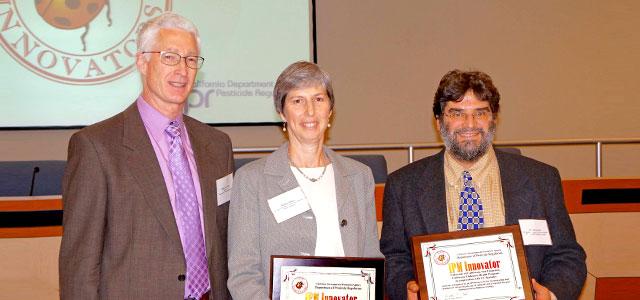
Abbey Alkon (center) and Asa Bradman (right) accept their Integrated Pest Management Innovator award.
Award-Winning Program Gives Child Care Centers Tools to Reduce Pesticide Use
In March 2013, Abbey Alkon, director of the UCSF California Childcare Health Program (CCHP), and environmental health epidemiologist Asa Bradman of UC Berkeley’s Center for Environmental Research and Children’s Health accepted an Integrated Pest Management Innovator award from the California Department of Pesticide Regulation (DPR). The yearly awards recognize organizations that promote prevention and least-harmful pest control measures.
Alkon and Bradman received the award for the CCHP’s Integrated Pest Management Toolkit for Early Care and Education Programs, which helps early care and education (ECE) facilities comply with the Healthy Schools Act. This 2000 state law, which was expanded in 2006, requires schools and ECE centers to keep records and notify parents when certain pesticides are used, and encourages centers to adopt an integrated approach to pest management that emphasizes preventing infestation, using least-harmful methods to combat pests first and saving pesticides as a last resort.
Taking a Precautionary Approach to Reduce Potential Harm
A 2010 report by the National Association of Child Care Resource & Referral Agencies (now known as Child Care Aware of America) notes that more than 11 million children under age 5 in the US spend an average of 36 hours per week in child care, which explains concerns about pesticides in child care and early education facilities. Pound for pound, children eat, drink and breathe more than adults, and their natural exploring behaviors, such as touching and mouthing objects, can expose them to pesticides that leave residue on surfaces or in the soil. Yet children’s physiologic immaturity puts them at increased risk for adverse health effects, including neurological, behavioral, respiratory and developmental problems associated with pesticide exposure.
While California has banned several older pesticides with known toxicity to humans, the cumulative effects of newer ones, particularly among children, isn’t fully understood. This was the impetus behind extending the Healthy Schools Act to include early care and education facilities and promoting integrated pest management (IPM) as a less risky solution to pest problems. “There’s a growing understanding that reducing exposures makes public health sense,” says Bradman.
To quantify the magnitude of the problem, he conducted a survey of 637 California child care centers and found that 55 percent used pesticides, and 47 percent used sprays and foggers that could leave residue in the air or on surfaces, increasing the potential for exposure. One in five centers reported using pesticides monthly or even weekly. That suggested, says Bradman, that some facilities were using pesticides as a preventive measure rather than as a targeted solution to an acute problem.
The reasons cited for this frequent use – that pesticides were easier, safer or more convenient than other pest control methods – told Bradman and Alkon that education on IPM might help mitigate the problem.
Creating and Evaluating a Toolkit for Child Care Professionals
Using a 2009 DPR grant, Alkon and Bradman assembled a multidisciplinary team that developed a research-based curriculum for early care professionals, including information on the law, common pests, pesticides and the risks they pose, and a specific set of recommendations for implementing IPM. The accompanying toolkit contained fact sheets on individual pests that Bradman’s research had identified as most problematic, and provided information on IPM strategies to deal with them.
The team – which included health care providers, nurses, child care professionals, environmental epidemiologists, entomologists, pest management experts and pesticide regulators – also created educational presentations in English and Spanish for staff and families, along with posters that reinforce important messages and remind staff of best practices. An advisory panel of ECE professionals reviewed the toolkit to ensure that the messages and tools were appropriate and practical in a child care setting.
Alkon – who has spent more than a decade studying health and safety problems for children attending child care programs – conceived the IPM checklist with a researcher’s eye. “I wanted to have an objective assessment,” she says. The checklist helps outside evaluators and child care center staff look for evidence of pests or pest damage and assess the pest management practices of a facility. Alkon and her co-investigators also used the checklist as the basis for research that evaluated the toolkit’s effectiveness in helping ECEs use IPM to reduce pest problems.
As part of a pilot study, research assistants went into nine California-licensed child care centers, using the checklist to assess conditions conducive to pest infestation, like broken screens that could provide an entryway for pests or leaky faucets that could provide water sources to roaches, rats and mice. The research assistants also looked for evidence of existing pest problems and documented them in photographs. CCHP nurse Vickie Leonard, Bradman and their research assistants then conducted workshops to educate ECE staff about pests and pest control, and trained child care staff in IPM. The centers received ongoing support and tools, including caulking, special dusters for hard-to-reach areas and self-contained ant traps.
When they assessed the pilot centers six months later, Alkon and her co-investigators found that the centers’ use of recommended IPM practices had increased by 68 percent. “Most of the problems were gone,” she says. “The centers that had pests in the initial assessments had none.”
Alkon and her co-investigators published the results last year in the journal Early Childhood Research & Practice. She has secured funding from the DPR for a larger study of the toolkit’s effectiveness using the same protocol in 45 centers across three counties, a project that began in January 2013 and will continue through the year.
“We need to give people evidence-based tools to encourage them to not use sprays, which get into the air and settle in the ground, because they are toxic for children,” says Alkon.



